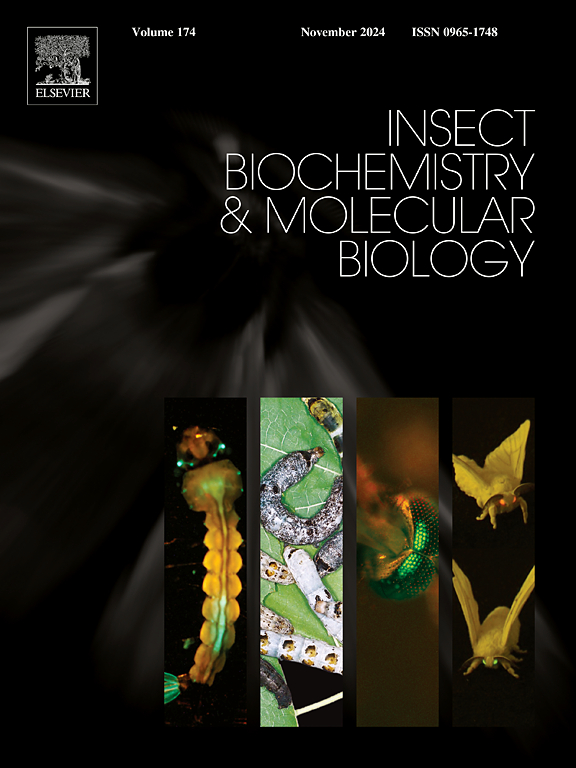Regulation of tick attachment and rapid engorgement via dopamine receptors in the Asian longhorned tick Haemaphysalis longicornis
IF 3.7
2区 农林科学
Q2 BIOCHEMISTRY & MOLECULAR BIOLOGY
引用次数: 0
Abstract
Dopamine plays multifaceted roles in the physiology of insects and ticks, acting as a key neurotransmitter and modulator of various biological processes. In ticks, it plays a particularly important role in regulating salivary gland function, which is essential for successful tick feeding on hosts. Salivary secretion in ticks is orchestrated by the collection of saliva in the acinar lumen mediated by the dopamine receptor (D1) and the expulsion of collected saliva into the salivary duct mediated by the invertebrate specific D1-like dopamine receptor (InvD1L). However, the function of dopamine receptors in different feeding stages and other tissues remains unclear. In this study, D1 and InvD1L of Haemaphysalis longicornis (Haelo-D1 and Haelo-InvD1L, respectively) were found to be involved in tick attachment and the rapid phase of blood feeding. Both receptors were identified and profiled in the synganglion, salivary glands, and midgut of H. longicornis females across different feeding stages. Functional analyses revealed that both receptors were activated by dopamine in a concentration-dependent manner with distinct sensitivities. RNA interference (RNAi) targeting these receptors significantly reduced dopamine-mediated salivation and delayed tick attachment and blood feeding. Furthermore, RNAi prolonged rapid engorgement phases and reduced the final body weight of replete ticks. These results highlight the crucial roles of D1 and InvD1L in regulating salivary secretion in ixodid ticks and facilitating their attachment and rapid engorgement, thereby offering potential targets for novel tick control strategies aimed at disrupting feeding and reducing pathogen transmission.

多巴胺受体对亚洲长角血蜱附着和快速膨胀的调节。
多巴胺在昆虫和蜱虫的生理中起着多方面的作用,是一种关键的神经递质和多种生物过程的调节剂。在蜱虫中,它在调节唾液腺功能方面起着特别重要的作用,这对蜱虫成功捕食宿主至关重要。蜱的唾液分泌是由多巴胺受体(D1)介导的唾液在腺泡腔内的收集和无脊椎动物特异性D1样多巴胺受体(InvD1L)介导的唾液排入唾液管。然而,多巴胺受体在不同取食阶段和其他组织中的功能尚不清楚。本研究发现长角血蜱的D1和InvD1L(分别为Haelo-D1和Haelo-InvD1L)参与了蜱的附着和快速吸血阶段。在不同的摄食阶段,这两种受体分别在长角瓢虫的神经节、唾液腺和中肠中进行了鉴定和分析。功能分析显示,这两种受体都以浓度依赖的方式被多巴胺激活,具有不同的敏感性。针对这些受体的RNA干扰(RNAi)显著降低了多巴胺介导的唾液分泌,延迟了蜱的附着和血液摄食。此外,RNAi延长了快速膨胀期,降低了饱腹蜱的最终体重。这些结果突出了D1和InvD1L在调节粘蜱唾液分泌、促进其附着和快速膨胀方面的重要作用,从而为旨在破坏摄食和减少病原体传播的新型蜱控制策略提供了潜在的靶点。
本文章由计算机程序翻译,如有差异,请以英文原文为准。
求助全文
约1分钟内获得全文
求助全文
来源期刊
CiteScore
7.40
自引率
5.30%
发文量
105
审稿时长
40 days
期刊介绍:
This international journal publishes original contributions and mini-reviews in the fields of insect biochemistry and insect molecular biology. Main areas of interest are neurochemistry, hormone and pheromone biochemistry, enzymes and metabolism, hormone action and gene regulation, gene characterization and structure, pharmacology, immunology and cell and tissue culture. Papers on the biochemistry and molecular biology of other groups of arthropods are published if of general interest to the readership. Technique papers will be considered for publication if they significantly advance the field of insect biochemistry and molecular biology in the opinion of the Editors and Editorial Board.

 求助内容:
求助内容: 应助结果提醒方式:
应助结果提醒方式:


